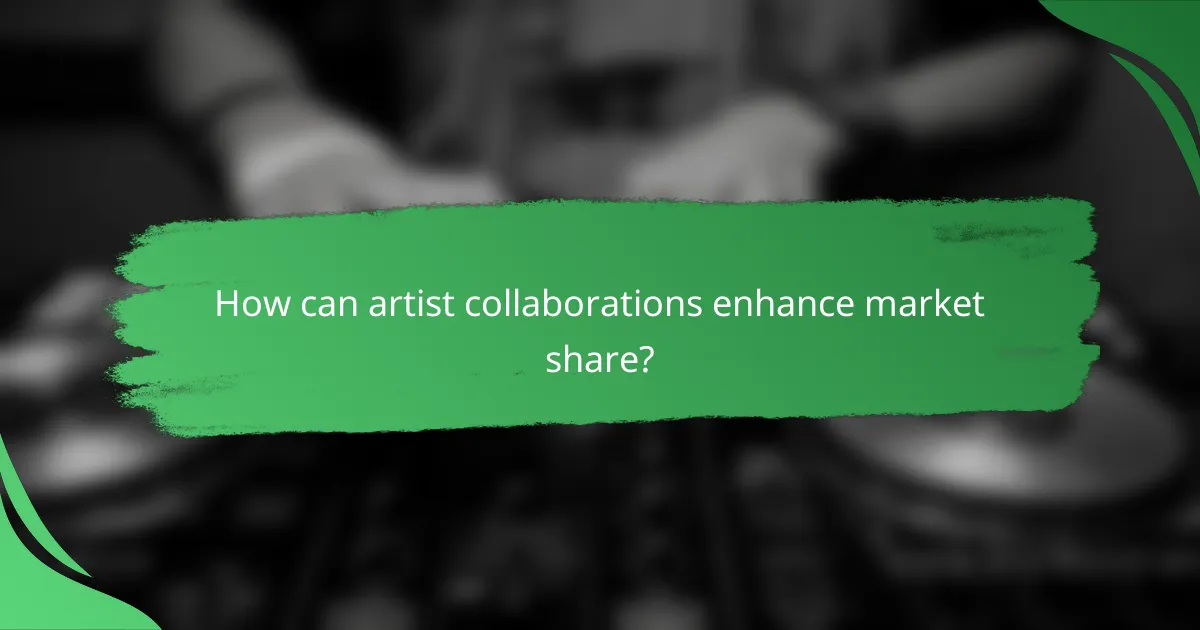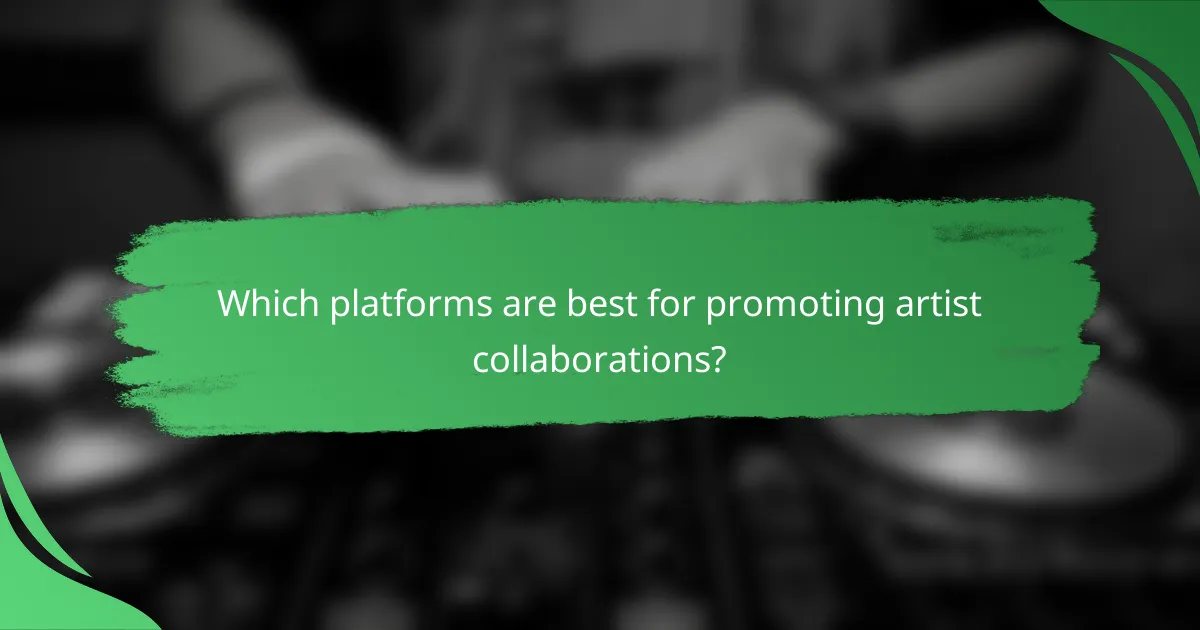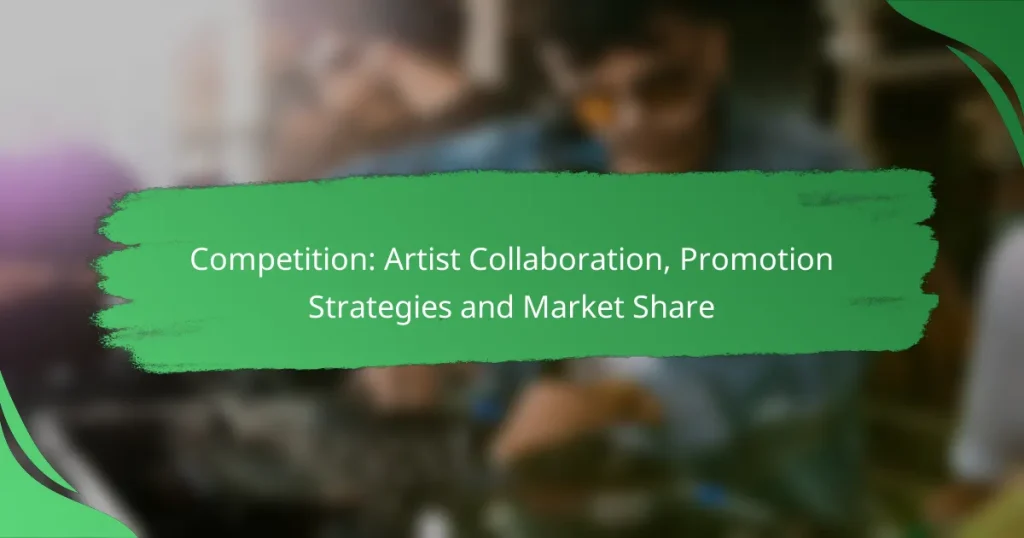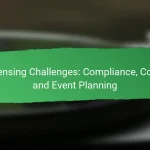Artist collaborations present a powerful opportunity to enhance market share by merging the unique strengths and fan bases of multiple creators. By leveraging effective promotion strategies such as social media engagement and influencer partnerships, these collaborations can significantly increase visibility and drive sales. Tailoring promotional efforts to the right platforms ensures that the content resonates with the target audience, maximizing engagement and impact.

How can artist collaborations enhance market share?
Artist collaborations can significantly boost market share by combining the strengths and fan bases of multiple creators. This synergy not only increases visibility but also opens doors to new audiences and shared resources, ultimately driving sales and engagement.
Increased brand visibility
Collaborating with other artists allows for cross-promotion, which can lead to heightened brand visibility. When two or more artists join forces, they can tap into each other’s marketing channels, such as social media, newsletters, and live events, amplifying their reach.
For instance, a musician partnering with a visual artist for an album cover can attract fans from both fields, enhancing exposure across diverse platforms. This increased visibility can lead to higher sales and a stronger market presence.
Access to new audiences
Artist collaborations provide access to new audiences that may not have been previously engaged. By working with artists from different genres or backgrounds, each party can introduce their work to a fresh set of potential fans.
For example, a pop singer collaborating with a hip-hop artist can attract listeners from both genres, expanding their market share. This strategy is particularly effective in diverse markets, where blending styles can resonate with a broader demographic.
Shared resources and costs
Collaborations often allow artists to share resources, reducing individual costs associated with production, marketing, and distribution. By pooling budgets, artists can invest in higher-quality projects that may have been financially unfeasible alone.
For instance, two artists might co-produce a music video, splitting the costs while benefiting from a more polished final product. This shared investment can lead to better returns and increased market competitiveness.
Enhanced creative output
Collaborating with other artists can lead to enhanced creative output, as different perspectives and skills combine to create unique works. This fusion of ideas can result in innovative projects that stand out in the market.
For example, a collaboration between a singer-songwriter and a producer can yield a fresh sound that attracts attention. The creative synergy often leads to higher-quality content, which can translate into increased sales and audience engagement.
Stronger community engagement
Artist collaborations can foster stronger community engagement by creating events and initiatives that resonate with fans. Joint projects often encourage participation, whether through live performances, workshops, or social media campaigns.
For instance, a local art and music festival featuring collaborative performances can draw larger crowds and create a sense of community. Engaging with fans in this way not only strengthens loyalty but also enhances the overall market share for the artists involved.

What are effective promotion strategies for artist collaborations?
Effective promotion strategies for artist collaborations include leveraging social media, forming influencer partnerships, organizing cross-promotional events, and implementing targeted email marketing initiatives. These methods enhance visibility, engage audiences, and ultimately drive sales and market share.
Social media campaigns
Social media campaigns are essential for promoting artist collaborations, as they allow for real-time engagement with fans. Platforms like Instagram, TikTok, and Facebook can be used to share behind-the-scenes content, teasers, and interactive posts that encourage audience participation.
Utilize hashtags and challenges to increase reach and visibility. For example, creating a unique hashtag for the collaboration can help track engagement and foster community interaction. Consider running contests or giveaways to incentivize sharing and participation.
Influencer partnerships
Partnering with influencers can significantly amplify the reach of artist collaborations. Influencers with a strong following in the relevant genre can introduce the collaboration to new audiences and lend credibility to the project.
When selecting influencers, consider their engagement rates and audience demographics to ensure alignment with your target market. Collaborations can include sponsored posts, live sessions, or exclusive previews, which can create buzz and drive traffic to streaming platforms or merchandise sales.
Cross-promotional events
Cross-promotional events, such as joint concerts or virtual meet-and-greets, can effectively showcase artist collaborations. These events not only attract fans from both artists but also create a unique experience that can be marketed as a special occasion.
Consider partnering with local venues or online platforms to host these events. Offering exclusive merchandise or limited-time access can further entice fans to participate and share their experiences on social media.
Email marketing initiatives
Email marketing initiatives are a powerful tool for promoting artist collaborations directly to fans. Building a subscriber list allows for personalized communication, where updates, exclusive content, and pre-sale access can be shared.
Segment your email list based on fan interests or previous engagement to tailor messages effectively. Use compelling subject lines and clear calls to action to encourage opens and clicks, ensuring that fans stay informed and engaged with the collaboration.

Which platforms are best for promoting artist collaborations?
Promoting artist collaborations effectively requires choosing the right platforms that align with the content type and target audience. Each platform offers unique advantages for visibility and engagement, making it essential to tailor strategies accordingly.
Instagram for visual content
Instagram excels in showcasing visual content, making it ideal for artist collaborations that involve photography, artwork, or fashion. High-quality images and engaging stories can capture attention and foster interaction among followers.
Utilize features like Instagram Reels and Stories to highlight behind-the-scenes moments or collaborative projects. Regularly engage with followers through polls and Q&A sessions to build a community around the collaboration.
Spotify for music collaborations
Spotify is a leading platform for music collaborations, allowing artists to reach a vast audience through playlists and shared tracks. Collaborating on a song or album can significantly increase exposure, as listeners often discover new music through curated playlists.
Consider creating a collaborative playlist that features both artists’ works, alongside the new collaboration. Promote the playlist across social media to drive traffic and encourage followers to listen and share.
YouTube for video content
YouTube is essential for promoting video content, making it a powerful tool for artist collaborations that involve music videos, vlogs, or tutorials. Engaging video content can attract a wide audience and encourage shares, boosting visibility.
Collaborate on a video that showcases the creative process or a live performance. Use SEO strategies in video titles and descriptions to enhance discoverability, and encourage viewers to subscribe for future content updates.
TikTok for viral marketing
TikTok is a dynamic platform for viral marketing, especially for music and short-form video content. Collaborations that leverage trending challenges or sounds can quickly gain traction and reach a younger audience.
Participate in or create challenges that highlight the collaboration, encouraging users to engage and share their own content. Use popular hashtags to increase visibility and consider partnering with TikTok influencers to amplify reach.

What are the key metrics for measuring collaboration success?
Key metrics for measuring collaboration success include engagement rates, sales growth, audience reach, and brand sentiment analysis. These metrics help determine the effectiveness of partnerships and promotional strategies in the competitive landscape of the art market.
Engagement rates
Engagement rates reflect how actively audiences interact with collaborative content, such as likes, shares, comments, and overall participation. A high engagement rate indicates that the collaboration resonates well with the target audience, which can lead to increased visibility.
To assess engagement, track metrics across various platforms, aiming for rates above industry averages, which typically range from 1% to 5% for social media posts. Consider using tools like Google Analytics or social media insights to gather data effectively.
Sales growth
Sales growth measures the increase in revenue generated from collaborative efforts, indicating the financial impact of the partnership. This metric is crucial for understanding whether the collaboration translates into tangible profits.
Monitor sales figures before and after the collaboration, looking for percentage increases that reflect the success of promotional strategies. A growth rate of 10% to 30% is often considered a strong indicator of effective collaboration in the art market.
Audience reach
Audience reach indicates the total number of unique individuals exposed to the collaborative project. This metric helps gauge the potential market size and the effectiveness of promotional channels used.
To measure reach, analyze metrics from various platforms, including social media, email campaigns, and website traffic. Aim for a broad reach, ideally expanding your audience by at least 20% through successful collaborations.
Brand sentiment analysis
Brand sentiment analysis evaluates public perception of the collaboration and the brands involved. Positive sentiment can enhance brand reputation and foster customer loyalty, while negative sentiment may indicate issues that need addressing.
Utilize social listening tools to monitor mentions and sentiment across social media and review platforms. Aiming for a sentiment score above 70% positive can signal a successful collaboration, while regular monitoring allows for timely adjustments to strategies if needed.

How do artist collaborations compare in different markets?
Artist collaborations vary significantly across markets, influenced by cultural preferences, consumer behavior, and industry practices. In some regions, collaborations can drive substantial market share, while in others, they may have limited impact.
Factors influencing artist collaboration success
Several factors determine the success of artist collaborations, including audience demographics, genre compatibility, and marketing strategies. For instance, collaborations in pop music often attract a younger audience, while those in classical music may appeal to a more mature demographic.
Understanding local tastes is crucial. In markets like the United States, collaborations between mainstream artists can lead to significant streaming increases, while in Europe, niche collaborations might resonate more with specific audiences.
Examples of successful collaborations in various markets
In the U.S., collaborations such as those between hip-hop and pop artists have proven highly successful, often resulting in chart-topping hits. For example, the partnership between a hip-hop artist and a pop singer can leverage both fan bases, maximizing reach.
In contrast, in markets like South Korea, K-pop collaborations often blend genres and include multiple artists, creating a unique sound that appeals to both domestic and international fans. This strategy has led to significant global market share for K-pop artists.
Challenges of artist collaborations
While artist collaborations can be beneficial, they also come with challenges. Misalignment in artistic vision or brand identity can lead to a lack of authenticity, which may alienate fans. It’s essential for artists to ensure that their collaboration feels genuine and resonates with their audiences.
Additionally, logistical issues such as scheduling conflicts and differing contractual obligations can hinder collaboration efforts. Artists should prioritize clear communication and mutual understanding to navigate these challenges effectively.
Strategies for effective artist collaborations
To maximize the potential of artist collaborations, consider establishing clear goals and expectations from the outset. This includes defining the target audience, desired outcomes, and promotional strategies.
Utilizing social media platforms for promotion can significantly enhance visibility. Engaging fans through behind-the-scenes content or interactive campaigns can also create excitement around the collaboration.
Finally, evaluating the success of the collaboration through metrics such as streaming numbers, social media engagement, and sales can provide valuable insights for future projects.


